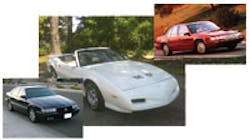This article is about a great new product with only one problem -- it needed to be designed years ago. As they say though, better late than never. What we are talking about is a new system to make keys for the GM six-cut VATS ignitions.
I was a little pessimistic when I first heard about this system. However, after running many tests on this system, my reservations are a thing of the past. This system was designed primarily for use on VATS ignitions, but we have tested it on other six-cut GM ignitions as well. The designer of this system is Tom Thill. Watch for other automotive products he is currently developing.
This system is called SIK, short for Sidebar Interrogation Keys. On our very first test use of the SIK system, we made a mechanical key for a Chevrolet Camaro. This was done in 10 minutes without pulling the steering wheel. We have never had any problems pulling the steering wheels, but many times the horn buttons on the wheel are old and the plastic has deteriorated to such an extent that removing the front cover off the wheel causes them to break. We are going to attempt explain how the SIK system works and show how a key is made.
The SIK system comes complete with several sets of test keys. See Figure 1. Do not confuse these keys with conventional tryout keys. The first set of keys you use will then point you to a second set. With a little practice, you will be making keys in a very short order.
Each set, A & B, contains 70 keys. They are grouped in sets 1A, 2A, 3A, 4A, 5A, 1B, 2B, 3B, 4B and 5B.
Making A Working Key
Making a working key for the car is fairly simple. We are going to make a key for a Cadillac column. See Figure 2. Start with any group of keys in set A. Insert the first key in the ignition and, using your other hand, put medium turning pressure on the lock ears in towards the on position. See Figure 3. With the turning pressure applied, pull the key straight out firmly with your thumb and finger. Do not pull with excessive force. If the key pulls out, go on to the next key. If the key binds, continue on with the rest of the keys in the set and make note of any keys that bind. You should not get keys in any other set to bind. Take the ones that bind and retest them again by turning the lock towards the accessory position. You will find that only one or two will bind in both directions. The key that was binding for this lock was #72 from the “A” set.
Next, look on the supplied chart to determine which keys in set “B” to test. You will find that there are very few keys to test. On our test lock, there were four test keys to choose from. Check these keys exactly like you did with the keys from group “A”. Key #74 from the “B” set bound. See Figure 4.
The chart , gave us the first four cuts: 5543. We then did a normal progression for cut numbers 5 and 6. Our final cuts were 554312. This key turned the lock smoothly. See Figure 5.
Using Genericode, we then did a reverse code lookup and found the actual code was 80A9. See Figure 6. Although this was not necessary to making the key, we always give the customer the actual key code written on our business card.
For 1993. GM changed the VATS locks. They stopped stamping the key codes on the sides of the ignition locks. This means that if you do remove the lock, you normally have to disassemble it to get the cuts.
When this change took effect, they also made it easier for us to decode the lock without disassembly. The individual wafers in the locks were numbered on the side that can be read through the keyhole. This also allows us to shortcut the first step of going through the “A” keys at random. If we can see the first wafer number, it tells us which set of “A” keys to use. This means a maximum of 15 “A” keys to test. Add a couple of “B” keys and it is not going to take long to make a key.
It took about 10 minutes total time to make the mechanical key, including the extra time it took to take pictures. The only thing left to do was to interrogate the system to find the correct VATS value.
We have always thought that we were pretty fast in pulling the wheel and removing the lock to make a key. The average time pulling down the column, making a mechanical key and putting it back together was around 20 minutes. With this system, we are cutting that time to about one third.
Although GM six-cut locks are no longer being used by the manufacturer, there are a huge number of these out there. This fact coupled with GM no longer giving out key codes makes the addition of this kit a powerful tool in our arsenal. For further information regarding this system, contact Mike Bronzell by E-mail or phone 708-259-9956.
Dennis and Josh Heath are experts in the automotive locksmith field. Besides being working automotive locksmiths, they are instructors in many facets of this specialty. This includes easy ways of making automotive and motorcycle keys, high security keys and transponders. The Auto & Bike Pros website is currently under construction.





